
 One particular week in Bitburg, Germany, I wound up on the late shift with scheduled landings around sunset. There was often a haze layer at low altitude that required the localizer or TACAN to help us find the runway for our VFR arrivals, but this week was remarkably clear. We mostly used Runway 24, not only for the prevailing winds but also to avoid nearby Spangdahlem Air Base to the northeast.
One particular week in Bitburg, Germany, I wound up on the late shift with scheduled landings around sunset. There was often a haze layer at low altitude that required the localizer or TACAN to help us find the runway for our VFR arrivals, but this week was remarkably clear. We mostly used Runway 24, not only for the prevailing winds but also to avoid nearby Spangdahlem Air Base to the northeast.
My first mission of the week was in a four-ship formation as the No. 2 F-15. Our VFR arrival and pitchout to downwind, and then base, was normal and uneventful—until I started to roll out on final. I realized that the setting sun was aligned directly with the end of the runway. It was nearly impossible to see straight ahead for landing. I was waiting for a call from our flight lead to see if he would come up with an alternate plan for us, but I heard nothing, and never saw him go around, so I assumed he landed fine. With my ego in hand, I continued my approach, relying heavily on visual cues to either side of the jet, and managed to land OK as well.
We had an interesting debrief about our recovery.
“Could you see the runway?”
“Not at all.”
“That was pretty hairy.”
“Maybe we should have landed on Runway 6 … especially since the winds were calm.”
So there you have it: four mighty egos flying four mighty jet fighters, and everyone “manly” enough to land as assigned on the active runway—the runway we couldn’t really see. The next afternoon we took off at the same time on Runway 24 but coordinated to land on Runway 6. What a nice change that was.
How many of our local airports have a preferred landing runway? How many fly-ins have you been to where you are just one of many in the flow to land on some particular runway? And how many times has the sun, a crosswind, or a tailwind dictated that you probably should not be landing on that runway? I was on the ground at a fly-in watching arrival after arrival touch down halfway down a 4,000-foot-runway because of a tailwind on final that didn’t show on the windsock. Someone finally exercised his PIC authority and announced that he would break out and wait so that he could land on the opposite runway. Soon everyone followed and I didn’t hear any more squealing tires from pilots stomping on the brakes the rest of the day.
When cleared to land on a runway that isn’t the best option for you, don’t be afraid to pull out an old anti-drug slogan and “Just say no.”
Larry Brown of Colorado Springs, Colo., is a retired Air Force F-15 pilot who is using the lessons he learned as a fighter pilot as a GA pilot in his Cessna P210. Brown, who has 2,600 hours total time during his 32 years of flying, also was an instructor pilot and flight examiner in the Air Force T-38 and instructor pilot in the T-52, the military’s version of GA’s Diamond DA40.
We are testing this new biweekly series. Tell us what you think! )



